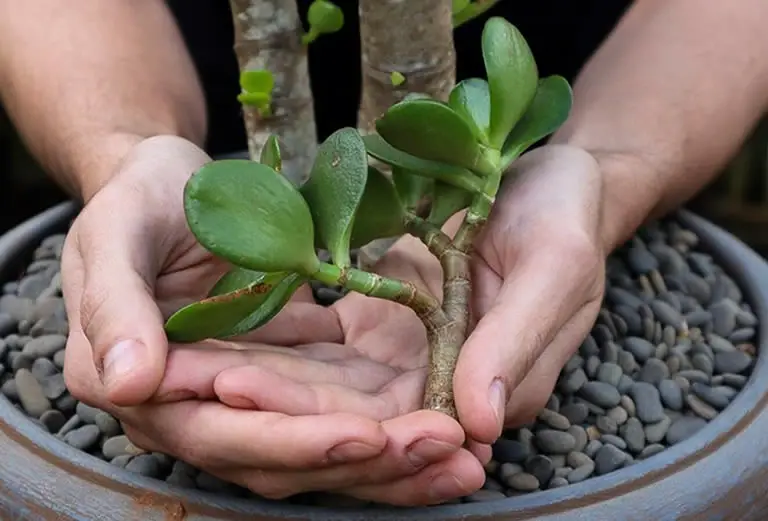There’s something extra satisfying about propagating a Jade Plant. Maybe it’s the sturdy, glossy leaves. Maybe it’s the symbolism of growth, luck, and prosperity. Or maybe it’s just how incredibly easy this succulent is to multiply—because honestly, Jade practically wants to become more plants.
Whether you want to fill your home with more green, share cuttings with friends, or create a little bonsai forest, propagating Jade Plant is low-effort and super rewarding.
Let’s walk through all the propagation methods that work for this classic succulent—including how to grow it outside if you’re lucky enough to have the right climate.
Table of Contents
- Why Jade Plant Is So Easy to Propagate
- Leaf Propagation: A Simple Start for Small-Scale Success
- Stem Cuttings: The Fastest and Most Reliable Method
- Division: Perfect for Extra-Large Plants
- Water Propagation: Possible, But Not Preferred
- Outdoor Propagation: Yes, You Can Grow Jade in the Garden
- Caring for Your New Jade Cuttings
- Final Thoughts
Why Jade Plant Is So Easy to Propagate
Jade Plants are part of the Crassulaceae family, which includes many succulents known for effortless propagation.
They store water in their thick leaves and stems, so they can survive periods without roots—which makes them perfect candidates for cuttings.
With just a little time and the right conditions, a single stem or leaf can become a full, thriving plant.
Leaf Propagation: A Simple Start for Small-Scale Success
Leaf propagation is a fun and beginner-friendly method that’s perfect if you just want to grow a few new plants from a parent Jade.

Here’s how to do it:
-
Gently twist off a healthy, plump leaf from the main plant.
-
Let it callous for 1–3 days. This helps prevent rot when it’s placed on soil.
-
Lay the calloused leaf flat on top of well-draining soil. Don’t bury it.
-
Mist the soil lightly every few days or whenever it feels dry.
Over the next few weeks, you’ll see roots begin to form and, eventually, a tiny baby plant growing at the base of the original leaf.
Once it’s large enough to handle, it can be potted on its own.
Leaf propagation takes a bit more time than other methods, but it’s very satisfying to watch new life form from a single leaf.
Stem Cuttings: The Fastest and Most Reliable Method
This is the go-to method if you want a new Jade Plant quickly—or if your plant has become leggy and needs pruning.
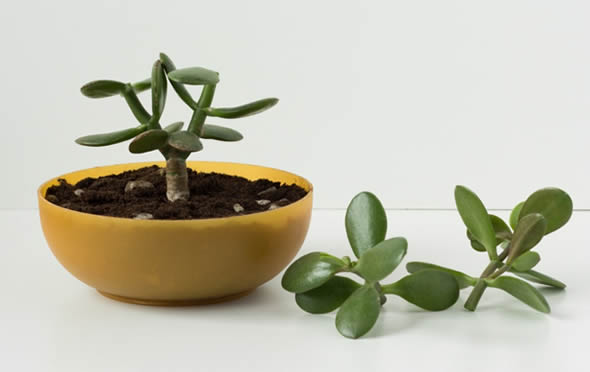
How to propagate with a stem cutting:
-
Use clean scissors or shears to take a healthy 3–6 inch stem cutting.
-
Remove the lower leaves from the bottom inch or two.
-
Allow the cutting to sit in a dry area for 2–5 days so the cut end can callous.
-
Plant the cutting upright in dry, well-draining succulent soil.
-
Wait a few days, then water lightly once the soil is fully dry.
Rooting usually takes place within a couple of weeks. New leaves and branches will begin to form once the plant has settled in.
This method is ideal if you’re shaping your Jade Plant into a bonsai form, or if you simply want more mature plants sooner.
Division: Perfect for Extra-Large Plants
If your Jade Plant has grown large and full, you may be able to divide it into two or more smaller plants.
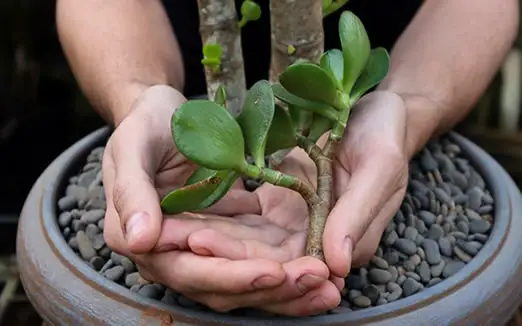
How to divide a Jade Plant:
-
Gently remove the entire plant from its pot.
-
Look for natural separations or clumps in the root system.
-
Use your hands or a clean knife to separate the root balls into smaller sections, making sure each has stems and healthy roots.
-
Let the divisions sit for a day to callous if you had to cut any roots.
-
Replant in fresh, dry succulent soil and water after a few days.
This is a great way to refresh an overgrown plant and give it a little breathing room—while getting free plants in the process.
Water Propagation: Possible, But Not Preferred
Unlike many houseplants, Jade isn’t a big fan of sitting in water.
While some gardeners have had success rooting stem cuttings in water, it’s generally not recommended.
Why? Because:
-
Water roots don’t transition well to soil.
-
The cutting is more prone to rot.
-
It’s slower and less reliable than dry-soil methods.
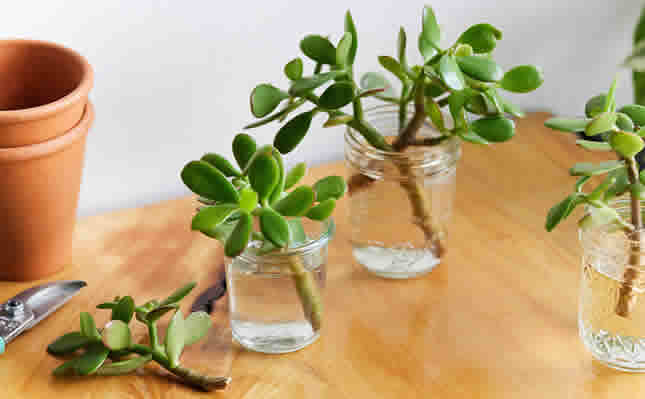
If you’re curious and want to try it, use only stem cuttings (not leaves), place them in a jar of clean water, and change the water every few days.
Move to soil once roots are about 1–2 inches long.
Outdoor Propagation: Yes, You Can Grow Jade in the Garden
If you live in USDA zones 9–11, you can absolutely propagate Jade Plant outdoors directly in your garden.
Here’s how to make it work:
-
Choose a bright, sunny location with well-draining soil—rocky or sandy soil is ideal.
-
Use any method above: stem cuttings, leaves, or even division.
-
Place the cuttings or leaves directly on the soil surface, and avoid watering for the first few days to allow for callousing.
-
In dry regions, mist lightly every few days to encourage rooting.
Once established, outdoor Jade Plants grow into low-maintenance shrubs and can be used as accent plants, container specimens, or even trimmed into hedges or bonsai-style shapes.
Caring for Your New Jade Cuttings
Once your new plant has taken root, treat it like a mature Jade:
-
Give it lots of bright, direct light
-
Use cactus or succulent soil with excellent drainage
-
Water only when the soil is fully dry
-
Avoid fertilizing for the first month—then feed lightly in spring and summer
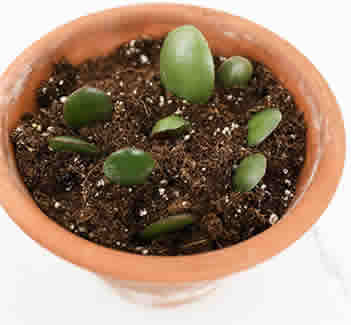
Rooting usually takes about 2–4 weeks, and visible new growth is a sure sign that your propagation was successful.
For a more detailed guide to caring for your Jade Plant read our article How to Care for a Jade Plant (Crassula ovata): A Classic Succulent That Brings Good Vibes and Easy Growth.
Final Thoughts
Whether you’re growing it for luck, beauty, or just the fun of propagation, Jade Plant (Crassula ovata) makes it easy to multiply.
With just a leaf, a cutting, or a divided root ball, you can grow an entire mini-forest of these charming succulents. Even better—every new plant feels like a little gift, full of potential and positivity.
Let me know if you’d like this turned into a visual step-by-step or printable handout for your readers or socials—I’d love to help bring it to life!

